My house smells like cat pee but I can’t find it ! This is what a pet parent of ours said when they came into our clinic. They were clearly frustrated. How can you find where your pet urinated in your home? You’ve tried to find it, but can’t. Sound familiar? Yes, you can smell that urine odor. But where is the cat pee smell coming from?
In this article, you will learn how to stop your house from smelling like cat pee, how to stop your pet from peeing in the house, how to find pet stains with a black light, and how to clean pet stains.
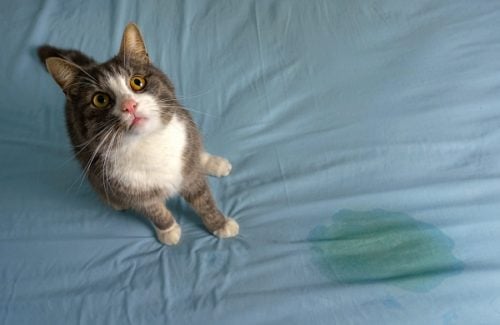
Navigation Tips
You have 3 ways to enjoy this article.
- If you want to learn as much as you can, feel free to read the entire article which starts after the Table of Contents
- If you have specific questions or topics you are interested in, you can click on the topic heading of your choosing in the Table of Contents below.
- If you are a visual learner, you can get the highlights by watching the video below.
Table of Contents
How to stop your house from smelling like cat pee
One important part of solving your cat’s litter box problems or your cat or dog peeing inside your home is to clean all the locations where they urinated. Usually pet owners wipe up the pee with paper towels and think that’s enough. Unfortunately it’s not. This is because your pet can smell it and knows that’s where they’ve urinated before. That means they will likely to do it again on that spot. The uric acid in pet urine is what makes cat urine odor so strong. Even if you clean the stain, the uric acid can linger if it wasn’t cleaned properly. You’ll want to use an enzyme cleaner. Some use baking soda and white vinegar. See below on our proven tips on how to clean those stains so your pet won’t go there again. And most of all, to get rid of that urine smell in your house.
The use of an air purifier to reduce the smell of pee in the house can help. They can be helpful if you’ve cleaned all the pee spots in the house and are now trying to remove litter box smells.
How to stop your pet from urinating in the house:
1. Make sure your pet is healthy. Your cat or dog may have an underlying health issue. They may be diabetic which causes them to drink more water and thus, need to urinate more. They may have a urinary tract infection or kidney disease which could be causing them to pee in the house. Take your pet to your veterinarian and discuss your concerns to make sure your pet is healthy.
2. Train your pet. You’ve likely already house broken your pet and they usually go outside. But they can regress, especially as they age. Cats and dogs like to eliminate shortly after eating. After their meal, take them to the area that they are supposed to go. When they do, praise them and even reward them with a treat. For your cat, make sure there is nothing that prevents them from using their litter box. This could be a noisy washing machine which scares them or the hum of an air conditioner. Also make sure your cat has a clean litter box. One of our cats refuses to go if she has a dirty litter box. So we have learned to clean it right after she uses it. Your cat may have preferences of how they like their litter box to be.
3. Clean the house. To prevent your pet from going again on the same spot, you have to remove as much of the stain as possible. This goes beyond just the unpleasant odors. Remember your pet has a sense of smell that is 14 times better than ours. The hardest spots to clean are rugs and carpets. This is because the cat urine smell is likely coming from deep in the fabric fibers. Using a carpet cleaner will help, make sure there is an enzymatic cleaner in the cleaning solution in the carpet cleaner machine to not only remove the cat pee odors, but to remove as much of the urine as possible. An enzyme cleaner breaks down the uric acid so it can evaporate. If the ammonia smell is really bad, hiring a professional cleaner company to clean your carpets may be needed. This is because their cleaning process is able to go much deeper than the steam cleaner we can rent from the store. One tip: Never put your cat’s litter box on carpet. The urine can get into the carpet padding under the carpet and it’s really hard to get rid of the strong odors.
But how do you know where the cat pee smell is coming from when it’s dried? Use a black light.
What is a black light, and how can it find pet urine?
Black light is also known as ultraviolet or UV light. UV light is simply light with a frequency higher than visible light. Okay enough of that, you aren’t here to learn physics right now. Just think of a rainbow and the different colors.
Water crystals break visible light into a spectrum in the rainbow where red has a lower visible frequency and violet has a more highly visible one. Anything lower than red is called infrared (which can be sensed as heat but you can’t see it), and anything higher than violet is ultraviolet light. This is why it’s known as black light because it’s not visible light.
Black light has many applications. For example, most paper money and some documents have markings that are visible under black light to prevent counterfeiting. UV light is used in the medical field for sterilization and disinfection purposes. We even use our blacklight flashlight to find scorpions at night in the yard. Even swimming pools and drinking water can be disinfected using UV lighting. Tanning beds use black light to stimulate additional Vitamin D production in your skin, eventually creating that supposedly healthy glow. Or was that just back in the 70’s?
UV light is also used in art to create drawings visible only under UV lighting. Body fluids, such as blood, urine, and semen, are easier to detect under UV light. For this reason, UV lights are used in crime scene investigations. Have you ever seen a purple toilet? It’s so the staff can see where one has urinated over the edge.
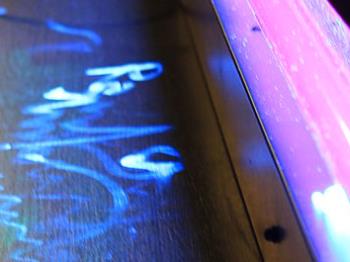
See where this is going? Cat urine spots literally glow in the dark when exposed to the black light. Even long after the wet urine has dried, its scent creating chemicals will still be visible even if the stain is hard to see. Thereby making pet urine stains including older dried urine easy to find. Black light is an easy cat urine spot detection device that anyone can use.
What kind of blacklight is used to detect cat urine and dog urine?
Many types of black light devices are available on the market with varying prices and sizes. The most popular come as a black light flashlight which use fluorescent UV bulbs and small LED lights.
An LED UV flashlight will outperform fluorescent lights. But you also need to take a look at the wavelengths your urine detector emits. Although light strength can vary from maker to maker, LED lamps are generally stronger and use less energy than a fluorescent type bulb. They are considerably stronger if you need to find dog or cat urine spots. By stronger we don’t mean the actual visible light which does not make cat urine glow, but rather the amount of UV light it emits.
The most important feature to look for in a urine detection UV flashlight is the wavelength in the description of the the particular UV flashlight that you are looking at. UV light wavelengths vary from 10 to 400 nm (nanometers, or billionths of a meter). A black light flashlight will be marked to indicate what wavelength they emit. You’ll most likely see an LED lamp powered UV flashlight with 400 nm, 385 nm, or 365 nm in the store. Try to avoid a UV flashlight with a wavelength of 395 or 400 nm. They are less useful in finding pet urine because they are emitting blacklight that is very close to visible light. For best results, we recommend going with a UV flashlight with 365 to 385 nm UV lights.
The number of LED bulbs also makes a difference in how easy it is to find pet urine. For household use you can easily go with 9 or 12 LED bulbs in a black light flashlight. As you can imagine, the more UV LED bulbs a UV flashlight has will increase the price. That said, it also makes finding that smelly stain easier.
The following contains affiliate links. As an Amazon Associate I earn from qualifying purchases. This is used for keeping the blog up and running smoothly. Please know this does not change the price you see on Amazon. Thank you for your help and support of Pet-Happy!
If you don’t have Amazon Prime, we highly recommend trying it. The biggest benefit is free shipping. Yes, free ! You can also get your orders in 1,2, and even same day along with 2 hour grocery delivery. One of our favorites is the free movies and TV shows on Amazon Prime. There are so many more benefits. To find out yourself, you can try Amazon Prime free for 30 days. If you have a Kindle and love reading like we do, you can also try Kindle Unlimited free for 30 days.

You can find blacklight lamps online. Click here to check out the PeeDar 2.0 UV flashlight we recommend and personally have from Amazon. Our favorite PeeDar 2.0 UV flashlight is compact, has 21 LEDs (yes, 21 !), and works perfectly every time. It’s really sturdy and even comes with 3 Alkaline batteries. The ones that came in the package weren’t a familiar brand name to me (the package says “brand name” AAA batteries, but they weren’t the Duracell brand ones in the picture), but they worked fine.The LEDs are recessed so they don’t get scratched when I’ve dropped it. It’s made of sturdy aluminium like a tactical flashlight. It has a rubber o-ring to seal the battery compartment. The instructions on the back say that it’s water resistant but I’ve never tested that feature. It’s got knurling on the case to help with gripping it, but they aren’t very rough so it can get a bit slippery. Even though it has a wrist strap, I’ve dropped it far too many times to count. Thankfully it just keeps working great. This UV flashlight even comes with a link on the package to download a 150+ page ebook titled “BEHAVIOURAL TRAINING GUIDE FOR DOGS AND CATS Understanding & Solving Unwanted Toilet Habits”. Best of all, it has a 2 year warranty.
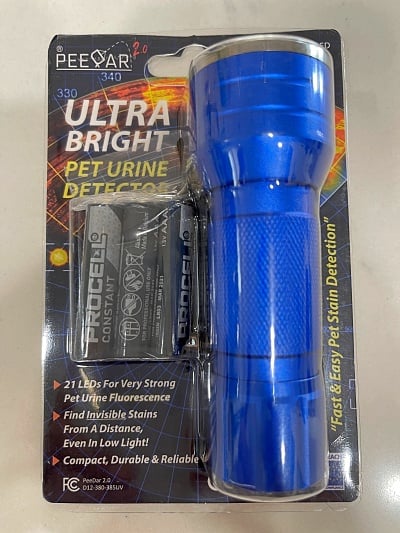
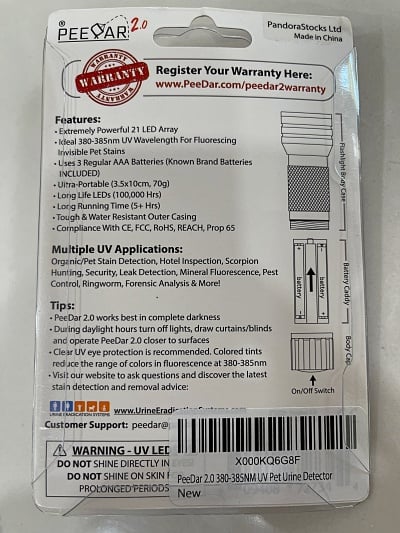
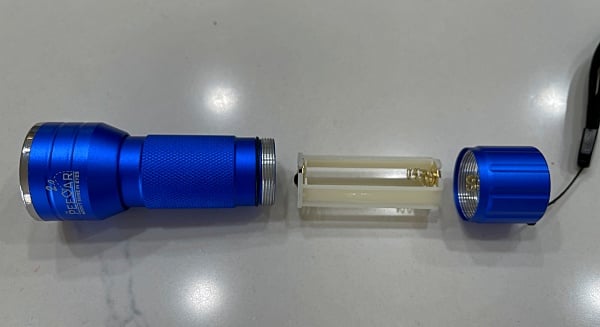
A good quality black light UV flashlight with LEDs should cost no more than $20 to $30. This means that the technology is affordable as a household item. It’s not high-end technology that is only available to scientists. You can find cheaper ones too. But most of them perform poorly for urine detection because the UV light they emit is not optimal for finding pet urine. We’ve tried many as have our patients. That is why we recommend the the one we and many of our patients use, the PeeDar 2.0 UV flashlight.
How does a blacklight help in finding cat urine and dog urine?
Now that you have the equipment aka “urine detector”, you are ready to find the dog or cat urine stain that is left on your floor, carpet, and furniture. It’s as simple as point and look but the following are a few tips to improve your search.
First thing to use is your nose. As a pet owner, you know that dog and cat urine smell very well, it’s pretty noticeable. So go to an area in your home where you smell the odor of dog or cat urine. Then use your urine detector to find the stain.
It will be easier to find the urine stains if you darken the room. Search in the evening or with the blinds closed, doors closed, and lights turned off. Dog and cat pee will still glow under UV in broad daylight. It’s just a little harder to find as you’ll have to point the UV blacklight right down onto the stain to notice it.
How do you find pet urine using a black light?
Turn the UV blacklight on and shine it on different surfaces. In general, if you are looking for house-soiling locations, you should look at all the horizontal surfaces, including bed sheets, furniture tops, bookshelves, your clothes, and even in sinks and bathtubs. For example if your cat is spraying urine, look on vertical surfaces as well. Especially near doorways, hallways, and corners. Find more about urine spraying here.
Turning on the black light the first time might be scary because everything may be glowing. Actually, there are several substances that glow when exposed to black light including some types of wallpaper glue.
All you have to do is determine whether what you are seeing looks like pet stains. Generally, you are looking for yellowish splatter, an individual urine spot, or drips. On vertical surfaces, you are likely to observe a single drop that has run down the wall before drying out. This video shows what urine looks like when viewed under a blacklight:
How do you get rid of the smell of cat pee if you can’t find it?
Use a blacklight and an enzyme-based cleaner. If your dog has been urinating in the house or your cat outside of the litter box for a while, you will see bright spots and weaker spots using a black light. The weaker spots are older and contain less of a concentration of chemicals that glow. That’s bad news for us because your pet is still able to smell where they peed or dribbled. That means they will continue to use that spot over and over.
Mark the locations where you find the dried urine stains as you won’t be able to see them when you turn the black light off. Anything will do, but we’ve found some Legos or other small objects work well to outline the area or mark the exact little spot.

Next, treat all the discovered locations with a cleaner intended for pet urine removal. We found Nature’s Miracle in the red and white spray bottle works wonders. It has enzymes to remove the proteins in the stains. It also helps remove the odor of cat urine and dog pee so your pet is less likely to “revisit” the same spot. We have a spray bottle of this stuff at the office, in every exam room at our veterinary clinic, and all over our house. It has a light scent and gets rid of that urine odor. Make sure to clean an area a little larger than the pee stain area you found with the blacklight flashlight. Find out how to clean pet urine here. First, doing so leaves no room for error. Second, pet urine tends to soak into surfaces (especially carpets), and what you see under a blacklight may just be the tip of the iceberg. If it’s on carpet, you may find that the padding underneath has also soaked up the urine.
Remember that knowing how to find pet urine is not the hardest part. Finding the dog or cat pee is just a single step along the path to making your house free of pet problems. For dogs, teaching them through positive reinforcement to urinate and poop where you want is the best course of action. You know known when they usually have to go, like right after they wake up or eat. Take them outside or where you want them to go. Teach them by giving them a command (we used “Get Busy” with ours). When they “do their business”, give them a treat and praise them lavishly. They’ll figure it out very quickly. If you would like additional help with a cat urine problem, please check out our article series about cat litter, litter boxes, and cat house-soiling problems here.
You have learned how to stop your house from smelling like cat pee, how to stop your pet from peeing in the house, how to find pet stains with a black light, and how to clean pet stains. You can use your skills to find that smelly pee stain that you can’t see. Further, you know how to remove not only the stain but the scent so that your pet won’t continue to revisit the same spot. Lastly, we offered some tips for teaching your pet where to do their business. You won’t be the person that says “My house smells like cat pee but I can’t find it” any longer. You’ll soon have a much nicer smelling home. This will go a long way towards a long and happy life with your pet cat and dog. And keeping your Pet happy is what we all want.
FAQ
Question: Can black light detect both cat and dog urine?
Answer: Yes. Black light can detect both cat and dog urine.
Question: Can black light detect pet urine on any surface?
Answer: Yes. Black light can detect pet urine on most surfaces, including carpet, hardwood floors, and fabric.
Question: Can black light detect pet urine stains even after they’ve been cleaned?
Answer: No. Black light cannot detect pet urine stains if they have been completely cleaned and removed.
Question: What should I do if I find pet urine stains with black light?
Answer: Once you find the pet urine stains with blacklight, use an enzymatic cleaner to remove the stains and the odor.
Question: Can black light be harmful to pets or humans?
Answer: Black light is generally safe for humans and pets, but prolonged exposure to UV light can cause skin damage and eye damage, so it’s best to use it in moderation and avoid shining it directly into your or your pet’s eyes.
